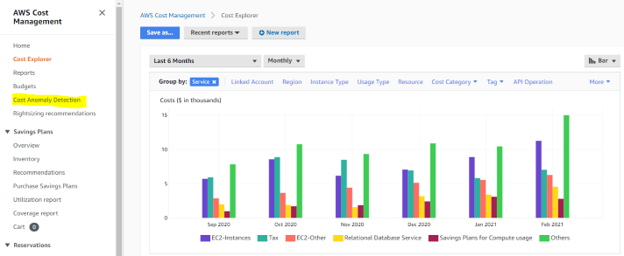Amazon Web Service’s Cost Anomaly Detection is a complimentary service that screens your spending trends to identify anomalous spending and provide in-depth cause analysis. Cost Anomaly detection helps to reduce unexpected cost surprises for customers.
AWS Cost Anomaly Detection is backed by sophisticated AI and machine learning algorithms and can recognize and distinguish between gradual increases in cloud costs and one-off expense spikes. You can create your cost anomaly detection parameters and cost anomaly alerts in simple steps. You can make different subscription alerts for a similar cost monitor or various cost monitors for one subscription alert based on your business needs.
With every anomaly discovery, this free service gives a deep dive analysis so users can rapidly identify and address the cost drivers. Users can also provide input by submitting reviews to improve the precision of future anomaly identification.
As a component of AWS’s Cost Management solution offering, Cost Anomaly Detection is incorporated into Amazon Web Service Cost Explorer so users can scan and identify their expenses and utilization on a case-by-case basis.
Steps to Use Cost Anomaly Detection
1. Enable Cost Explorer
AWS Cost Anomaly Detection is an element inside Cost Explorer. To get to AWS Cost Anomaly Detection, activate Cost Explorer. After you enable Cost Explorer at the admin account level, you can use AWS Identity and Access Management (IAM) to oversee admittance to your billing data for individual IAM clients.
You would then be able to give or deny access on an individual level for each account instead of allowing access to all accounts. An IAM client should have access to pages in the Billing and Cost Management dashboard. With the proper permissions, the IAM client should also see costs for his/her AWS account.
When you finish the setup, you should have access to AWS Cost Anomaly Detection. To get to AWS Cost Anomaly Detection, sign in to the AWS Management Console and open AWS Cost Management at https://aws.amazon.com/console/ .
Choose Cost Anomaly Detection on the navigation pane. After you enable the Cost Explorer, AWS prepares the data related to your expenses for the current month and year and projected figures for the following year. The current month’s information is accessible for reviewing in around 24 hours.
Yearly data takes a few days longer. Cost Explorer refreshes your cost information once every hour.

2. Create Monitor
AWS Cost Anomaly Detection right now supports four diverse monitor types:
- Linked subscription account
- AWS services (the only one that scans individual services for anomalies)
- Cost categories
- Cost allocation tag

Linked Account: This monitor assesses the spending of linked individual or group accounts. This type of monitoring can help your company segment cloud costs by teams, services, or environments attributable to an individual or group of linked accounts.
AWS Services: This monitor is recommendable for users who don’t want to segment AWS costs through internal usage and environment. The AWS service monitor individually assesses AWS services for oddities. As you use new AWS services, this monitor will automatically begin to assess that service for cost inconsistencies without any configuration obligations from you.
Cost Allocation Tag – Like the Linked accounts monitor type; the cost allocation tag monitor is ideal when you need to segment spend by groups (environment, product, services). This screen type limits you to one tag key with multiple tag values.
Cost Categories: Since the start of Cost Categories, numerous clients have begun utilizing this service to intelligently create custom groups that can allow them to efficiently monitor and budget spend as indicated by their company structure. If you currently use Cost Categories, you can choose Cost Categories as your cost anomaly detection type. This monitor type limits you to the Cost Category values.

3. Set alerts
When you enable anomaly detection for a metric, Cost Explorer applies machine learning and statistical calculations. These calculations evaluate system and application spend data in real-time to decide typical normal benchmarks and anomalies with minimal user intervention. The calculations produce a cost anomaly identification model. The model produces a scope of expected values that represent the typical trends of the metrics.
You can make anomaly detection alerts dependent on the typical, expected metric values. These kinds of alerts don’t have a static limit to decide the alarm state. All things being equal, they continuously compare the metric value to the expected value based on the anomaly discovery model. You can configure notification alerts when the measurement value is less or more than the normal value band.

To Conclude:
Cost Anomaly Detection by AWS provides a practical way to track and reduce costs in the cloud environment. IT, DevOps, and CostOps teams can now get a holistic understanding of cloud costs and budgeting and implement strategies that optimize resource utilization. Cost Anomaly Detection is the key to a profitable cloud.


